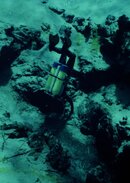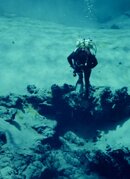Dale,
That diver has a Mk 13 Day/Night flare attached to his knife with masking tape. We did not use duct tape, as we needed to get the flare by breaking the tape, so masking tape worked to keep it is place. I guess it could be used as a shark repellant, but it was mainly for signaling during night jumps, or during day jumps where the conditions were pretty bad. It had an orange smoke for the day, and a bright light for night. I used one just once when we made a dive off an Okinawian flat-bottomed boat, and were swept away by the current in a search attempt for a helicopter that went down into the ocean in 1968. In ten minutes we were almost 1/4 mile away. They saw the smoke and came in to pick us up.
I've been trying to determine through my dive logs when I started using an SPG. I'll post more shortly. I have one photo from the mid-1970s which shows my equipment. I'm pretty sure I was using a SPG by this time. I participated in the Warm Mineral Springs Underwater Archaeological Project with Sonny Cockrell in about 1975. He required both the SPG and an octopus regulator for all divers, and I was a safety diver for the project that summer.
My first entry in a dive log was on June 25, 1973. It stated, "90. Used Dacor Dart reg.--when noticeably low on air (no sea view gauge) have 20 breaths." But I was recording "Air Used" since July 10, 1971. I may have been recording air pressure before and after the dive, however. On July 1, 1974 my log records, "...A pressure gauge is a must for planning these dives, and it should be planned like the astronauts plan EVAs (space "walks"), 'cause that's what we do when diving. The aqualung is not so much a tool as a life-support system for use in a cold & at least somewhat hostile water environment."
SeaRat
That diver has a Mk 13 Day/Night flare attached to his knife with masking tape. We did not use duct tape, as we needed to get the flare by breaking the tape, so masking tape worked to keep it is place. I guess it could be used as a shark repellant, but it was mainly for signaling during night jumps, or during day jumps where the conditions were pretty bad. It had an orange smoke for the day, and a bright light for night. I used one just once when we made a dive off an Okinawian flat-bottomed boat, and were swept away by the current in a search attempt for a helicopter that went down into the ocean in 1968. In ten minutes we were almost 1/4 mile away. They saw the smoke and came in to pick us up.
I've been trying to determine through my dive logs when I started using an SPG. I'll post more shortly. I have one photo from the mid-1970s which shows my equipment. I'm pretty sure I was using a SPG by this time. I participated in the Warm Mineral Springs Underwater Archaeological Project with Sonny Cockrell in about 1975. He required both the SPG and an octopus regulator for all divers, and I was a safety diver for the project that summer.
My first entry in a dive log was on June 25, 1973. It stated, "90. Used Dacor Dart reg.--when noticeably low on air (no sea view gauge) have 20 breaths." But I was recording "Air Used" since July 10, 1971. I may have been recording air pressure before and after the dive, however. On July 1, 1974 my log records, "...A pressure gauge is a must for planning these dives, and it should be planned like the astronauts plan EVAs (space "walks"), 'cause that's what we do when diving. The aqualung is not so much a tool as a life-support system for use in a cold & at least somewhat hostile water environment."
SeaRat
Attachments
Last edited:






